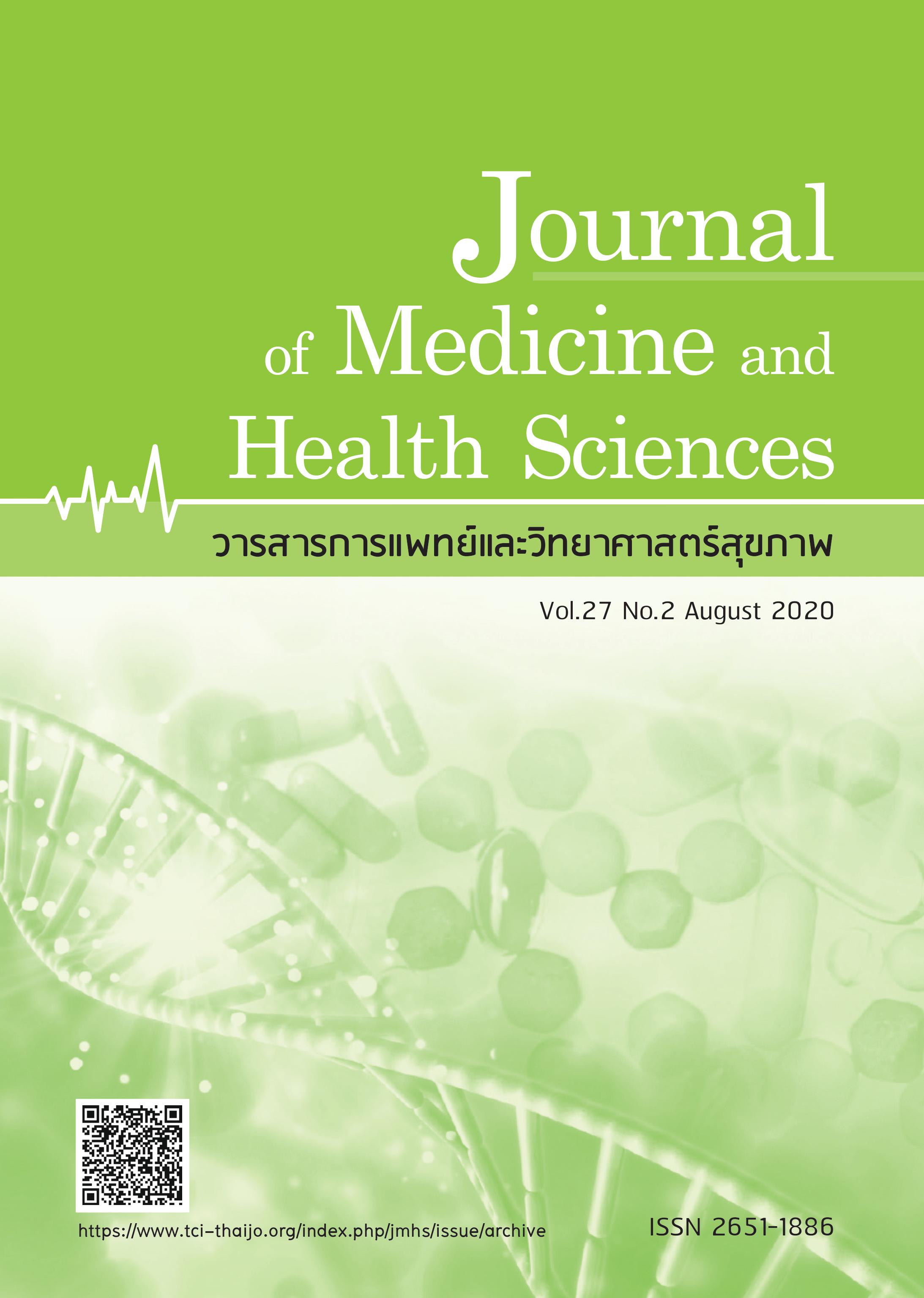A component analysis of palliative care for stroke patient
Keywords:
palliative care, stroke patients, factor analysisAbstract
The objective of this research was to describe factors and specific items identifying palliative care for Thai stroke patients. The sample consisted of 378 Thai nurses caring stroke patients for at least 2 years. They were asked to respond to the questionnaire representing palliative care domains. The questionnaire was developed by the researchers based on an integrative literature review and interviewing 18 experts who were specialized in caring for stroke patients and palliative care using Delphi technique. Reliability of the questionnaire tested by Cronbach alpha was 0.95. Data were analyzed using a Principle Component Factor Analysis with an Orthogonal Varimax Rotation. The result was that factors of palliative care for stroke patients consisted of 11 components, identified by 81 items, with 64.28 percent of total variance: 1) End of life care consisted of 10 items, explained the variance best, 9.58% 2) Participation and determination of care objective consisted of 12 items, explained the variance 8.88% 3) Coping with pain and spasticity symptom consisted of 11 items,
explained the variance 8.55% 4) Referring and palliative care system also consisted of 11 items with 7.69% of variance 5) Psychological and emotional care consisted of 9 items, with 7.39% of variance 6) Spiritual care consisted of 7 items, with 5.74% variance 7) Physical change after stroke consisted of 6 items with 5.26% of variance 8) Effective information consisted of 5 items, with 3.96% of variance 9) Facility and service consisted of 4 items, with 3.68% of variance 10) Preventing from pressure sore consisted of 3 items, with 3.35% of variance and 11) Care of stroke patients with communication disability consisted of 3 items, with 2.32% of variance. Research results also show the important factor and items in palliative care for stroke patients. Which can be used as data for the care management, developing health service systems and research development such as to create quality guidelines and service system for stroke patient’s care.
References
Strategy and Planning Division. Public Health Statistics A.D. 2018. Nonthaburi: Ministry of Public Health; 2019.
Kendall M, Cowey E, Mead G, et al. Outcomes, experiences and palliative care in major stroke: a multicentre, mixed-method, longitudinal study. CMAJ 2018;190(9):E238-46.
Holloway RG, Arnold RM, Creutzfeldt CJ, et al. Palliative and end-of-life care in stroke. Stroke 2014;45(6):1887-916.
Nuekwen P, Hanprasitkam K, Junda T. Nurses’ perceptions and practice on palliative care. Thai J Cardio-Thoracic Nurs 2016;27(1):128-41.
Lutz BJ, Green T. Nursing’s role in addressing palliative care needs of stroke patients. Stroke 2016;47(12):e263-5.
Macnee CL, McCabe S. Understanding nursing research: using research in evidence-based practice 2ed Wolters Kluwer Health/Lippincott Williams & Wilkins; 2008. p.126-32.
Polit D, Polit DF, Lake E. Statistics and data analysis for nursing research/Denise F. Polit 2ed Boston: Pearson, 2010. p.155-64.
Posai V. A Study of Palliative Care for Stroke Patients. Bangkok, Thailand: Chulalongkorn University; 2019.
Jevon P. Care of the dying and deceased patient: a practical guide for nurses: Wiley; 2009. p.1-36.
King IM. King’s theory of goal attainment. Nurs Sci Q 1992;5(1):19-26.
Treister AK, Hatch MN, Cramer SC, et al. Demystifying poststroke pain: from etiology to treatment. PMR 2017;9(1):63-75.
Payne S, Burton C, Addington-Hall J, et al. End-of-life issues in acute stroke care: a qualitative study of the experiences and preferences of patients and families.Palliat Med 2010;24(2):146-53.
Posai V, Pipatsombat P, Thangkratok P.Neuropsychiatric symptom clusters and quality of life among patients with stroke. Rama Med J 2019;42(2):1-11.
de la Mare B. The experience of stroke and the life of the Spirit. Med Humanit 2005;31(2):105-8.
Burton CR, Payne S, Addington-Hall J, et al. The palliative care needs of acute stroke patients: a prospective study of hospital admissions. Age Ageing 2010;39(5):554-9.
Yang NC, Yeh SH. [An experience applying a spiritual care model to a first-time stroke patient]. Hu Li Za Zhi 2012;59(3):113-8.
Creutzfeldt CJ, Holloway RG, Walker M. Symptomatic and palliative care for stroke survivors. J Gen Intern Med
;27(7):853-60.
Haruthai C, Leelawongs S, Atthachaiwat A, et al. Palliative nursing service system. Pathum Thani: Publishing of Suetawan Co; Ltd; 2016.
Bereded DT, Salih MH, Abebe AE. Prevalence and risk factors of pressure ulcer in hospitalized adult patients; a single center study from Ethiopia. BMC Res Notes 2018;11(1):847.
Chadchavalpanichaya N. Deconditioning syndrome from prolonged bed rest In: Pajareya K, editor. Rehabilitation in stroke patients Bangkok: LT Press Co., Ltd; 2007.
Chahine LM, Malik B, Davis M. Palliative care needs of patients with neurologic or neurosurgical conditions. Eur J Neurol 2008;15(12):1265-72.
Mazzocato C, Michel-Nemitz J, Anwar D, et al. The last days of dying stroke patients referred to a palliative care consult team in an acute hospital. Eur J Neurol 2010;17(1):73-7.



